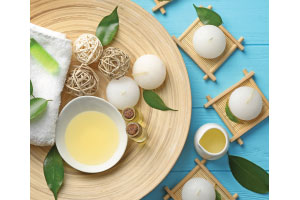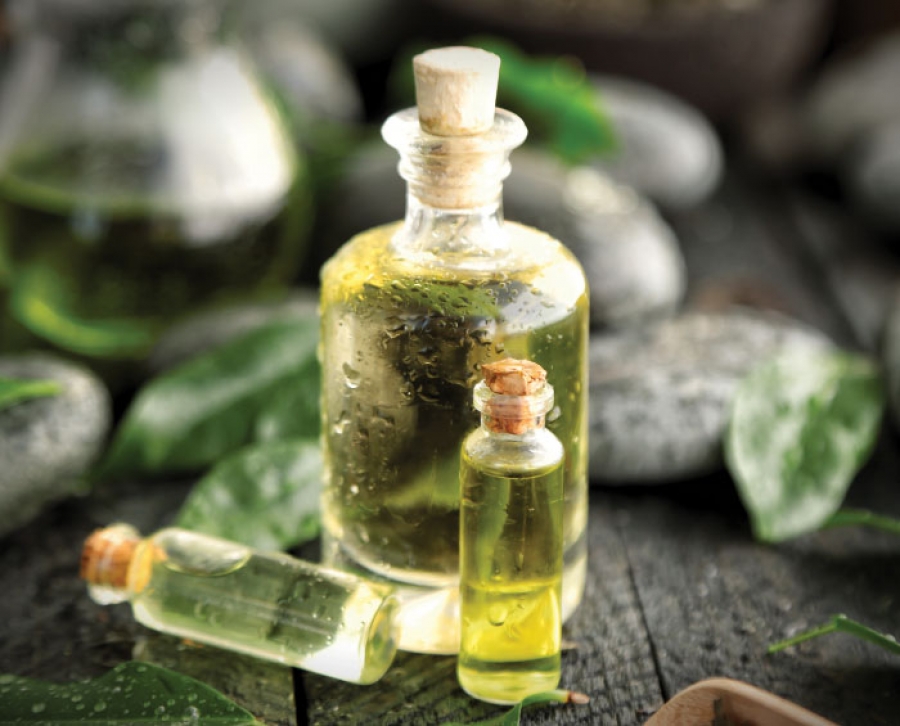During times of war, before pharmaceutical medicine was widely available, tea tree oil was a first aid necessity for the armed forces. Throughout history, tea tree oil has been used for many therapeutic and medicinal purposes. Today, tea tree oil is extensively recognized for its natural antimicrobial and antifungal characteristics, which make it valuable in the treatment of a range of skin, hair, and nail concerns.
 Malaleuca alternifolia (Australian tea tree), Leptospermum scoparium (New Zealand Manuka), and Kunzea ericoides (Kanuka) are the three different species of tea trees that are native to Northern New South Wales, Australia, and New Zealand. Tea trees are most valued for their foliage and branches from which the tea tree oil is derived through a process of steam distillation. Manuka and kanuka tea tree oils contain higher concentrations of antioxidants, but are less potent in their anti-germicidal and medicinal properties. They have not been thoroughly studied for toxicity and safety and, therefore, are not as common.
Malaleuca alternifolia (Australian tea tree), Leptospermum scoparium (New Zealand Manuka), and Kunzea ericoides (Kanuka) are the three different species of tea trees that are native to Northern New South Wales, Australia, and New Zealand. Tea trees are most valued for their foliage and branches from which the tea tree oil is derived through a process of steam distillation. Manuka and kanuka tea tree oils contain higher concentrations of antioxidants, but are less potent in their anti-germicidal and medicinal properties. They have not been thoroughly studied for toxicity and safety and, therefore, are not as common.
Since the 1920s, Malaleuca alternifolia has been extensively researched and tested. It is the source of the oil that is commercially available and used in the formulation of cosmetic products. Although it originally grew exclusively in the subtropical regions of Australia, it is now grown in other areas of the world, including California. Tea tree oil is abundant with terpinen-4-ol and cineole, which is responsible for the potent antimicrobial and anti-inflammatory characteristics of the oil. Tea tree oil has demonstrated antioxidant traits, but, most importantly, an ability to combat a full spectrum of bacterial, fungal, viral and even protozoal infections that affect the body.
ACNE
Papules, pustules, and comedones that accompany acne-related concerns are always directly linked to bacterial infection. Acne is more common among oilier skin types. When excess oil accumulates on the surface of the skin, it becomes an additional contributing factor to the development of breakouts because it can attract and breed more bacteria. Tea tree oil has a remarkable disinfecting and soothing effect on acne. The high concentration of terpinen-4-ol in the oil has strong antimicrobial traits that attack the bacteria and inhibit it from further aggravating the already-sensitive skin. The anti-inflammatory qualities of the oil work to calm and reduce the redness of acne-related breakouts. For safe results and to lower the chance of an adverse reaction, tea tree oil is most effective in a diluted form, such as a well-formulated skin care product.
Studies have shown that tea tree oil is as active in the treatment of acne as benzoyl peroxide. Even though tea tree oil may work slower to repair the breakout than benzoyl peroxide, it is equally as effective. Tea tree oil will not only treat the immediate symptoms of the acne, but also facilitate the healing of the tissue. Regular use will reduce the severity of acne and encourage clearer, healthier skin.
DANDRUFF
Flakiness of the skin, sensitivity, matting of the hair and even a sticky scalp are all symptoms common to those who suffer from dandruff, seborrheic dermatitis, psoriasis, and eczema. The biological and chemical structure of tea tree oil has qualities that function as a preventative against skin shedding. Studies show that tea tree oil improves dry skin. The oil works as a curative treatment against even the most severe form of clinical dandruff, which may be fungus related. The dominant antifungal action of the terpene hydrocarbons, especially the terpinen-4-ol, works in alleviating infections of this nature.
biological and chemical structure of tea tree oil has qualities that function as a preventative against skin shedding. Studies show that tea tree oil improves dry skin. The oil works as a curative treatment against even the most severe form of clinical dandruff, which may be fungus related. The dominant antifungal action of the terpene hydrocarbons, especially the terpinen-4-ol, works in alleviating infections of this nature.
INFECTION
The diversity of yeast, fungi, and bacteria are the primary culprits of tinea infections. Conditions like athlete’s foot (tinea pedis), ringworm of the skin (tinea corporis), fungal nail infection (onychomycosis), and even yeast infections can be extremely uncomfortable and even painful. Tea tree oil has a significant penetrating ability. The anti-inflammatory, soothing properties of the oil will alleviate discomfort accompanying the infection. The natural and safe antiseptic and fungicide assets of tea tree oil improve and remedy such infections. In the case of a fungal nail infection, pilot-testing suggests that direct application of undiluted tea tree oil two times a day to the affected areas worked as effectively as pharmaceutical medicines.
Although an open wound may be excessively sensitive, tea tree oil rids the tissue of pus, allowing for the germicidal properties of the oil to take full effect. Unlike most germicides, tea tree oil heals without affecting or destroying the tissue. Even before tea tree oil became globally recognized, Australian people traditionally used it as a home remedy for scratches, burns, cuts, and skin irritations caused by insect bites.
AROMATHERAPY
Not only is tea tree oil a phenomenal healing extract, but it is also an important oil to integrate into the practice of aromatherapy. Incorporate tea tree oil into facial or body treatments by mixing a few drops into a massage cream, balm, or oil to initiate a spiritual cleansing. Tea tree oil has long been believed to strengthen, protect, purify, and open blocked channels and chakras, encouraging internal clarity and balance.
CONTRAINDICATIONS
Although there are numerous benefits of tea tree oil, some clients may have an allergic reaction to the oil. According to the May 2006 issue of Food and Chemical Toxicology Journal, topical use of the oil is relatively safe and adverse events are typically minor, self-limiting, and occasional. Contact dermatitis is a common allergic skin reaction that can develop if high concentrations of undiluted tea tree oil is applied directly to the skin.
 This reaction can occur if there is no buffer between the oil and the skin. To decrease the possibility of a negative topical response, tea tree oil is best utilized for skin, body, and hair care when complimented by other ingredients in professional products.
This reaction can occur if there is no buffer between the oil and the skin. To decrease the possibility of a negative topical response, tea tree oil is best utilized for skin, body, and hair care when complimented by other ingredients in professional products.
Even though tea tree oil is a remarkable remedy for most people, especially those stricken with infection, it is not safe for women to use during childbirth. Contact with the oil can cease contractions and become a major risk for both the baby and mother.
TEA TREE OIL IN BEAUTY PRODUCTS
Many products in the beauty industry take advantage of the benefits of tea tree oil. Creams, shampoos, soaps, deodorants, and even organic disinfectant cleaning products have made their way into spas and salons. Tea tree oil has a distinct aroma with a note of spice and a hint of camphor/eucalyptus-like cooling scent. The presence of the oil can often be identified in a product simply by the hint of the raw tea tree fragrance. The pigment of the oil can vary from clear to yellow, but generally does not influence the overall product color.
Historically, tea tree oil has proven to have strong antiseptic, fungicide, and curative abilities. Until now, Australians have done the primary research and testing, but researchers across the globe are studying its benefits. It is certain that further uses and applications of the oil will be discovered, making the ingredient of the past a modern-day wonder.
 Victoria Tabak is a two-state licensed aesthetician and the president of Nature Pure Labs. She began her involvement in the aesthetics industry early in life and now has more than 18 years of experience, along with a Master’s Degree in Business, minoring in chemistry. For over a decade, she has taught classes on emerging breakthroughs in the anti-aging skin care industry and has inspired many.
Victoria Tabak is a two-state licensed aesthetician and the president of Nature Pure Labs. She began her involvement in the aesthetics industry early in life and now has more than 18 years of experience, along with a Master’s Degree in Business, minoring in chemistry. For over a decade, she has taught classes on emerging breakthroughs in the anti-aging skin care industry and has inspired many.
-
 Bella Schneider Beauty
Bella Schneider Beauty
Bella Schneider Beauty
Bella Schneider Beauty
-
 Bio France Lab
Bio France Lab
Bio France Lab
Bio France Lab
-
 Bon Vital’®
Bon Vital’®
Bon Vital’®
Bon Vital’®
-
 GR8SKN
GR8SKN
GR8SKN
GR8SKN
-
 Colorado Aromatics
Colorado Aromatics
Colorado Aromatics
Colorado Aromatics
-
 Danne Montague-King®
Danne Montague-King®
Danne Montague-King®
Danne Montague-King®
-
 Dermastart
Dermastart
Dermastart
Dermastart
-
 Dermaware®
Dermaware®
Dermaware®
Dermaware®
-
 Dr. Jeff® Skin Care/Beauty Attica
Dr. Jeff® Skin Care/Beauty Attica
Dr. Jeff® Skin Care/Beauty Attica
Dr. Jeff® Skin Care/Beauty Attica
-
 ECHO2Plus
ECHO2Plus
ECHO2Plus
ECHO2Plus
-
 Éminence Organic Skin Care
Éminence Organic Skin Care
Éminence Organic Skin Care
Éminence Organic Skin Care
-
 GlyMed Plus
GlyMed Plus
GlyMed Plus
GlyMed Plus
-
 Institut’ DERMed
Institut’ DERMed
Institut’ DERMed
Institut’ DERMed
-
 Lycon Precision Waxing
Lycon Precision Waxing
Lycon Precision Waxing
Lycon Precision Waxing
-
 Nature Pure Labs
Nature Pure Labs
Nature Pure Labs
Nature Pure Labs
-
 PurErb Skincare
PurErb Skincare
PurErb Skincare
PurErb Skincare
-
 Raya
Raya
Raya
Raya
-
 Rhonda Allison Cosmeceuticals
Rhonda Allison Cosmeceuticals
Rhonda Allison Cosmeceuticals
Rhonda Allison Cosmeceuticals
-
 Skin Blends
Skin Blends
Skin Blends
Skin Blends
-
 Skin Script Skin Care
Skin Script Skin Care
Skin Script Skin Care
Skin Script Skin Care
https://www.dermascope.com/resources/the-natural-wonders-of-tea-tree-oil?print=1&tmpl=component#sigProIdc211971f73
